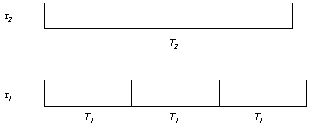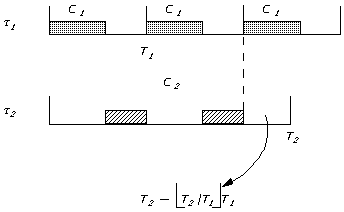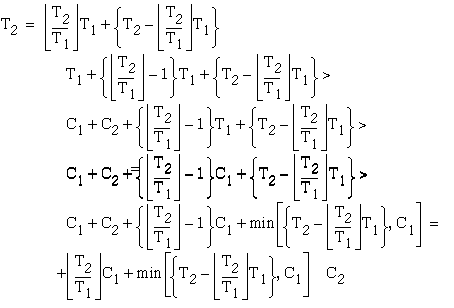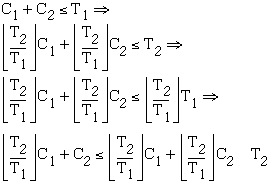2.1 Fixed Priority Scheduling (Rate Monotonic Scheduling)
Denote by ![]() m tasks, by
m tasks, by ![]() ; i =1, 2, ... m their request
periods and by
; i =1, 2, ... m their request
periods and by ![]() i=1, 2, ... m their execution times.
i=1, 2, ... m their execution times.
Define as ri the response time for a task ti as the time span between its request and the end of the response to the request. Note that during the response time of a task, no lower priority tasks can execute and that the deadline of a task coincides with the end of its period

Figure 2.1: A periodic task, its run and response times.
Define as the critical instant for a task t i as the instant at which the request for this task would have the largest response time.
Define as a critical time zone for a task the response time of a critical instant.
Theorem 2.1: A critical instant for any task occurs whenever the task is requested simultaneously with requests for all higher priority tasks. Proof
2.2 Scheduling two Periodic Tasks
Given two tasks ![]() and
and ![]() with repetition periods T1 and T2 and execution
times C1 and C2 . We shall attempt to define conditions
so that they will be schedulable (i.e. terminate within their deadlines).
with repetition periods T1 and T2 and execution
times C1 and C2 . We shall attempt to define conditions
so that they will be schedulable (i.e. terminate within their deadlines).
Assume, without loss of generality, that ![]() .
.
a.
Assign ![]() higher priority than
higher priority than ![]() .
.

Figure 2.3
Then it is obvious that (in the worst case as required
by Theorem
2.1) task ![]() must complete within T1 and must leave enough time for task
must complete within T1 and must leave enough time for task
![]() to complete before its deadline at
to complete before its deadline at ![]() . This can only happen if
. This can only happen if
![]() (2.1)
(2.1)
b. Assign
![]() higher priority than
higher priority than ![]() . Then, task
. Then, task ![]() will be preempted
will be preempted ![]() times during one period T2 . Again, we consider the worst possible
case as outlined previously when the two tasks
times during one period T2 . Again, we consider the worst possible
case as outlined previously when the two tasks ![]() and
and ![]() commence execution simultaneously.
commence execution simultaneously.
Necessary and sufficient conditions for feasible scheduling are
![]() (2.2)
(2.2)
![]() (2.3)
(2.3)
 (2.4)
(2.4)
To explain relations (2.2),(2.3) and (2.4), refer to the following diagram

Figure 2.4
Since ![]() is of higher priority than
is of higher priority than ![]() , it will continuously pre-empt
, it will continuously pre-empt ![]() . During T2, it will pre-empt
. During T2, it will pre-empt ![]()
![]() times, and it will consume
times, and it will consume ![]() plus portion of the remaining time which is
plus portion of the remaining time which is ![]() .
.
If ![]() is less than
is less than ![]() , then there will be some time left over for
, then there will be some time left over for ![]() to run.
to run.
If ![]() then all the remaining time (
then all the remaining time (![]() ) will be used by
) will be used by ![]() .
.
Therefore, the quantity ![]() gives the time, towards the end of
gives the time, towards the end of ![]() , used by
, used by ![]() .
.
Observe now that if (2.1) is satisfied, then (2.4) is also satisfied. Indeed
 (2.5)
(2.5)
From the above, one observes that if (2.1) is true, no
matter which schedule is followed (i.e., ![]()
![]() or
or ![]()
![]() [
[![]()
![]() signifies that task
signifies that task ![]() has lower priority than task
has lower priority than task ![]() ]) it is always possible for
]) it is always possible for ![]() and
and ![]() to meet their deadlines.
to meet their deadlines.
On the other hand, if (2.4) is satisfied (which is a more
general case, i.e., larger set of choices for ![]() and
and ![]() ) only
) only ![]() f
f![]() satisfies a feasible schedule.
satisfies a feasible schedule.
We call this type of scheduling rate-monotonic scheduling .
It is also worth noting a necessary (but not sufficient) condition.
Given that tasks ![]() and
and ![]() are feasibly scheduled, then
are feasibly scheduled, then
![]() (2.6)
(2.6)
Observe now that from (2.1), we can also obtain (2.6) above as follows:
 (2.7)
(2.7)
Theorem 2.2: If a feasible priority assignment exists for a set of tasks, the rate-monotonic priority assignment is feasible for that task set. Proof
Proceeding in the same way, one can achieve rate-monotonic feasible scheduling, from any given feasible schedule.
2.3 Achievable Processor Utilization (part 2)